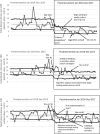Dissemination of a Novel Framework to Improve Blood Culture Use in Pediatric Critical Care
- PMID: 30584639
- PMCID: PMC6221585
- DOI: 10.1097/pq9.0000000000000112
Dissemination of a Novel Framework to Improve Blood Culture Use in Pediatric Critical Care
Abstract
Introduction: Single center work demonstrated a safe reduction in unnecessary blood culture use in critically ill children. Our objective was to develop and implement a customizable quality improvement framework to reduce unnecessary blood culture testing in critically ill children across diverse clinical settings and various institutions.
Methods: Three pediatric intensive care units (14 bed medical/cardiac; 28 bed medical; 22 bed cardiac) in 2 institutions adapted and implemented a 5-part Blood Culture Improvement Framework, supported by a coordinating multidisciplinary team. Blood culture rates were compared for 24 months preimplementation to 24 months postimplementation.
Results: Blood culture rates decreased from 13.3, 13.5, and 11.5 cultures per 100 patient-days preimplementation to 6.4, 9.1, and 8.3 cultures per 100 patient-days postimplementation for Unit A, B, and C, respectively; a decrease of 32% (95% confidence interval, 25-43%; P < 0.001) for the 3 units combined. Postimplementation, the proportion of total blood cultures drawn from central venous catheters decreased by 51% for the 3 units combined (95% confidence interval, 29-66%; P < 0.001). Notable difference between units included the identity and involvement of the project champion, adaptions of the clinical tools, and staff monitoring and communication of project progress. Qualitative data also revealed a core set of barriers and facilitators to behavior change around pediatric intensive care unit blood culture practices.
Conclusions: Three pediatric intensive units adapted a novel 5-part improvement framework and successfully reduced blood culture use in critically ill children, demonstrating that different providers and practice environments can adapt diagnostic stewardship programs.
Figures
Similar articles
-
Association of Diagnostic Stewardship for Blood Cultures in Critically Ill Children With Culture Rates, Antibiotic Use, and Patient Outcomes: Results of the Bright STAR Collaborative.JAMA Pediatr. 2022 Jul 1;176(7):690-698. doi: 10.1001/jamapediatrics.2022.1024. JAMA Pediatr. 2022. PMID: 35499841 Free PMC article.
-
Association of a Clinical Practice Guideline With Blood Culture Use in Critically Ill Children.JAMA Pediatr. 2017 Feb 1;171(2):157-164. doi: 10.1001/jamapediatrics.2016.3153. JAMA Pediatr. 2017. PMID: 27942705
-
Critical Care Network in the State of Qatar.Qatar Med J. 2019 Nov 7;2019(2):2. doi: 10.5339/qmj.2019.qccc.2. eCollection 2019. Qatar Med J. 2019. PMID: 31763205 Free PMC article.
-
Implementing early mobilisation in the intensive care unit: An integrative review.Int J Nurs Stud. 2018 Jan;77:91-105. doi: 10.1016/j.ijnurstu.2017.09.019. Epub 2017 Oct 2. Int J Nurs Stud. 2018. PMID: 29073462 Review.
-
Frameworks for quality improvement in pediatric intensive care: A concise review.Pediatr Investig. 2019 Jun 25;3(2):117-121. doi: 10.1002/ped4.12134. eCollection 2019 Jun. Pediatr Investig. 2019. PMID: 32851302 Free PMC article. Review.
Cited by
-
Diagnostic Stewardship of Endotracheal Aspirate Cultures in a PICU.Pediatrics. 2021 May;147(5):e20201634. doi: 10.1542/peds.2020-1634. Epub 2021 Apr 7. Pediatrics. 2021. PMID: 33827937 Free PMC article.
-
Practices, Perceptions, and Attitudes in the Evaluation of Critically Ill Children for Bacteremia: A National Survey.Pediatr Crit Care Med. 2020 Jan;21(1):e23-e29. doi: 10.1097/PCC.0000000000002176. Pediatr Crit Care Med. 2020. PMID: 31702704 Free PMC article.
-
Comparison of Administrative Database-Derived and Hospital-Derived Data for Monitoring Blood Culture Use in the Pediatric Intensive Care Unit.J Pediatric Infect Dis Soc. 2023 Jul 31;12(7):436-442. doi: 10.1093/jpids/piad048. J Pediatric Infect Dis Soc. 2023. PMID: 37417679 Free PMC article.
-
Diagnostic stewardship in infectious diseases: a scoping review.J Med Microbiol. 2024 May;73(5):001831. doi: 10.1099/jmm.0.001831. J Med Microbiol. 2024. PMID: 38722316 Free PMC article.
-
Use of Human Factors and Ergonomics to Disseminate Health Care Quality Improvement Programs.Qual Manag Health Care. 2019 Apr/Jun;28(2):117-118. doi: 10.1097/QMH.0000000000000211. Qual Manag Health Care. 2019. PMID: 30921286 Free PMC article. No abstract available.
References
-
- Weiss SL, Fitzgerald JC, Pappachan J, et al. ; Sepsis Prevalence, Outcomes, and Therapies (SPROUT) Study Investigators and Pediatric Acute Lung Injury and Sepsis Investigators (PALISI) Network. Global epidemiology of pediatric severe sepsis: the sepsis prevalence, outcomes, and therapies study. Am J Respir Crit Care Med. 2015;191:1147–1157.. - PMC - PubMed
-
- Hartman ME, Linde-Zwirble WT, Angus DC, et al. Trends in the epidemiology of pediatric severe sepsis. Pediatr Crit Care Med. 2013;14:686–693.. - PubMed
-
- Bone RC, Fisher CJ, Jr, Clemmer TP, et al. Sepsis syndrome: a valid clinical entity. Methylprednisolone Severe Sepsis Study Group. Crit Care Med. 1989;17:389–393.. - PubMed
Grants and funding
LinkOut - more resources
Full Text Sources

